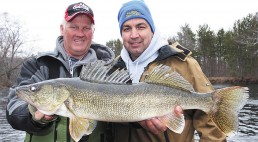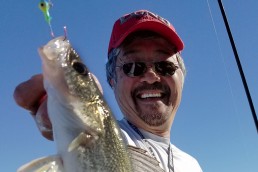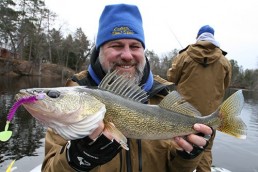Give the Walleyes the Ring this Spring
SHARE THIS POST
It’s big walleye time right now folks. Time to pull out the boat and head to your favorite river for some of the best walleye action you will see all year. If you don’t have a boat, you can grab the insulated waders, a few rods and a life jacket for early- season combat fishing, or, better yet, hire a good walleye guide to put you on the hot bite.
The big draws each March and April are the Rainy River on the Minnesota/Ontario border, the Fox River at De Pere and various dams in Wisconsin and Illinois, the Oconto, Peshtigo and Menominee rivers north of Green Bay, the St. Croix River in Minnesota, the Mississippi River in Minnesota, Iowa, Wisconsin and Illinois and the Maumee River in Ohio.
Top river fishing spots for spring walleyes are below dams, in the flats between bends and in the river bends where the deeper holes are. Another hot spot is the source of the river where a river starts from a main lake.
As walleyes make their migration to spawn, the smaller males arrive first and will push all the way up the dam or to the swiftest current. The females show up after, but will stage-up in the deeper holes until the temperature is right. Usually after the spawn, they will hole-up in the flats. So, the point is you need to move about and try various areas to determine where the hot bite is. Also, you can catch pre-spawn, spawners and post-spawners all from the same river, depending on your location.
Hot tactics for springtime walleyes are working jig-n-minnow combos, ripping blade baits, casting crankbaits and jig-n-ringworms. Ringworms have really had a resurgence in the past few years, and if you want to catch the big ones, give ‘em a “ring.”
B-Fish-N Tackle’s original Ringworm revived the revolution about 10 years ago. Ringworms had been around for a long time, but not in B-Fish-N’s array of color combinations—there are 36 colors in all. The key to the Ringworm’s fish appeal, beside the color, are the rings, which make a bubbling sound when in motion, and the large twister tail, which attracts and makes noise.
There are a variety of ways to work a jig-n-ringworm, and though trial and error you should be able to determine the right presentation. The key is the weight of the jig. On some days, the walleyes are super-tight to the bottom and a heavy jig is needed to keep in constant contact with bottom. This dragging method works well, except when snags are present, which in this case, you spend more time snagging than catching.
A lighter jig allows the Ringworm to tic the bottom every so often, and usually the preferred presentation. The lighter jig will not snag as much. I like to cast off to the side, slightly upstream, and allow the Ringworm to float and bounce downstream then drag it back for another cast. When you get the hang of it, you are almost steering it into the strike zone, and when the action gets hot, you can make “the called shot”—like if Babe Ruth was a walleye fisherman.
When fishing a dam, anchor down from the dam and cast up to it. Try to match the weight of the jig to current speed and you won’t hang up. Cast out a jig and see if it bounces downstream with a little help from the retrieve, and if it doesn’t move with a little coaxing, retie on a lighter jig. One thing is for sure when fishing a dam: The walleyes will really slam the Ringworm.
Are you enjoying this post?
You can be among the first to get the latest info on where to go, what to use and how to use it!
When fishing a deep hole, anchor the boat upstream and then cast slightly off to the side and let the current sweep the Ringworm downstream. Use just a heavy enough jig so that it tics the bottom once and a while. On the retrieve, pull in the line with your rod tip and give it a few short pumps as you are reeling it in.
The B-Fish-N Tackle’s Ringworm collection doesn’t just start and stop with the original; they also offer the Authentix line of plastics, which include the 4-inch Moxi and the 3-inch Moxi Ringworm. The Moxi has a much bigger body than the standard Ringworm, as well as a larger thumper tail. The 4-inch is for when the fish are really aggressive and the 3-inch is for when they are not. There are also paddle tail versions of the Moxi called Pulse-R’s, for when the walleyes aren’t as aggressive.
When it’s time to choose a jig head for a Ringworm, you want one that holds the Ringworm tight to the head and doesn’t hang up in the rocks and junk on the bottom. B-Fish-N H20 jigs fit the bill nicely; their wire “keeper” is molded into the jig head and holds the plastic fast to the head.
Like we said before, jig weight makes all the difference in the action of the Ringworm. Just enough is all you need. The H20 jigs come in nine different weight sizes, all from 1/16 up to 5/8 ounce. Plus, the weight of each jig is stamped right on the head for easy selection.
If you are really having trouble with snags, then the B-Fish-N Draggin’ Jig is for you. The unique wedge-shaped thin head design prevents snags. Many anglers will cast a Draggin’-Ringworm behind the boat and slowly troll upstream. The snag-free design allows the jig to drop in holes and in and around snags, where the big ones lurk.
So this month, break out the boat, waders or hire a guide for some of the fastest walleye fishing of the year.
Walt Matan and his father Poppee are the chief lure designers for Custom Jigs & Spins. For more information on ice fishing and to see all of Custom Jigs & Spins tackle log on to customjigs.com or call 800-831-5535 for a free, all-new catalog. You can also log on to frabill.com to check out the Ice Hunter Series rod and reel combos and the Sentinel one-man tents.
For more information…
To find out more about B-Fish-N Tackle’s line of Ringworms, jigs and blade baits go to bfishntackle.com or you can link to it via customjigs.com. Also, be sure to like Custom Jigs & Spins, B-Fish-N Tackle and Walt Matan on Facebook for some up-to-the-minute info.
MWO
SHARE THIS POST
Did you enjoy this post?
You can be among the first to get the latest info on where to go, what to use and how to use it!
Walt Matan
Walt Matan has been a writer and television host for MidWest Outdoors for 30 years. An avid ice and open-water fisherman, he currently lives in the Quad Cities on the shores of the Mississippi River. He is the product developer and brand manager for Custom Jigs & Spins, B-Fish-N Tackle, and Rippin Lips Catfish Tackle. For more information visit customjigs.com.



